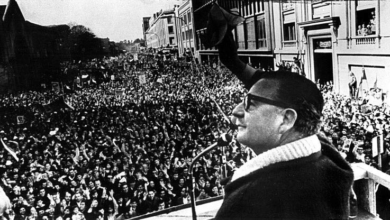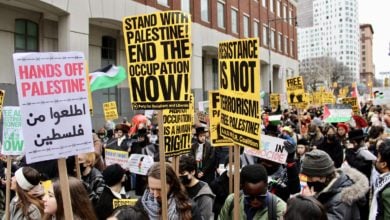On Dec. 16, 2009, the Revolutionary Armed Forced of Colombia (FARC) and the National Liberation Army (ELN) released a joint statement, revealing a plan of unity between the two main guerrilla forces in Colombia. “Our only enemy is U.S. imperialism and its lackey (Colombian) Oligarchy.” (Columbia Reports, Dec. 16, 2009)
The statement articulated the right-wing President Alvaro Uribe’s failure to bring about any political, social justice or economic change to the country over the last eight years. Because of the economic erosion of the country, 61 percent of the population live in extreme poverty. Some 7,500 political prisoners are incarcerated in maximum security prisons, and over 18,500 Colombians have been disappeared by the government in collaboration with right-wing paramilitary groups.
The Uribe government has been hard at work promoting a U.S. military expansion in the country. The FARC/ELN statement reads: “Today, Colombia is to be converted into a military base at their (U.S. imperialism’s) disposal to drown in blood the resistance of our people and from here, they seek to reverse the new project in our America that rides along the valleys and mountains. … The Empire plans to trample on our national dignity, the desire of Colombians, and impose their will at gunpoint through institutional paramilitary repression and with a corrupt political mafia.”
The approval of seven new U.S. military bases in the spring of 2009 has had a polarizing effect in the entire continent. It further strained the relationship between Colombia and its neighbors, who have all indicated their discontent. Venezuela, Bolivia and Ecuador, as well as Brazil and Argentina, have all called the new bases a deterrent to the unity and integration process of the continent. President Hugo Chavez of Venezuela stated, “[T]hose are bases for intelligence, primarily a place for espionage, from which they will plan invasions, bombings, they will plan acts of war. … ” (Telesur, Nov. 13, 2009)
As the armed resistance unified, the Colombian government has stepped up its attacks. It moved militarily in the last weeks of 2009 to deal successive blows to the guerrilla units in the southern region of Caqueta and Meta.
According to the government, 22 FARC rebels were killed and eight captured in a January 1 attack. The recent attacks also resulted in the deaths of the governor of Caqueta and long-time paramilitary collaborator Luis Francisco Cuellar, who had been captured by the guerrillas.
The attacks come in the wake of the release of Pablo Emilio Moncayo and Josue Daniel Calvo, long-time prisoners of war held by the FARC. The efforts were frustrated by the government, which has repeatedly refused to negotiate a prisoner exchange offered by the FARC. Instead, it has carried out military attacks on FARC campsites with the supposed aim of liberating guerrilla-held prisoners of war.
Through the past decade, the United States has invested over $6.5 billion in military aid to Colombia, first under the guise of the war on drugs, then the war on terror, and now for the purpose of “intelligence gathering.” The new military bases are part and parcel of a growing United States military presence in Latin America, to try to turn back the tide of revolutionary and progressive developments in the continent, including the establishment of the U.S. Fourth Fleet on the Atlantic coast.
The unity statement of the Colombian guerrilla movement is a welcome development, especially in the face of growing U.S. intervention.






